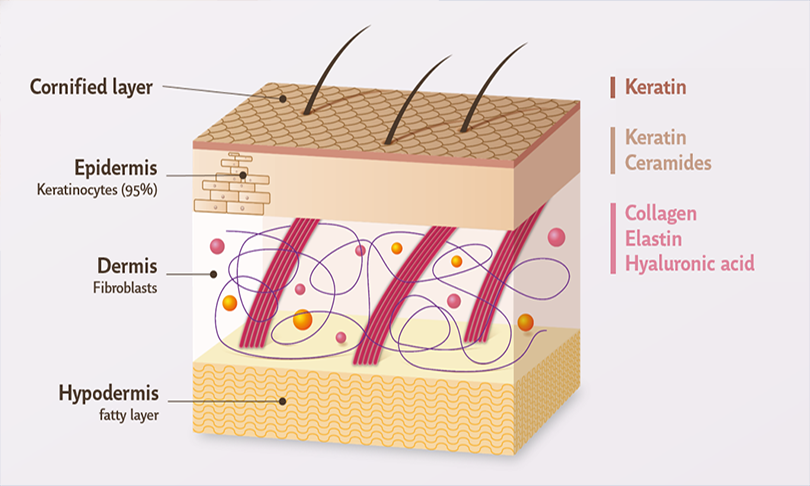
What is skin made of ?

Skin is more than just a covering for our body. Skin is more than just a covering for our body. It is a complex organ that carries out many important functions. It protects our body from the outside world, as well as revealing it. But what is it made of? Here’s what you need to know!
Skin accounts for 7% of an adult’s total weight1. It is divided into three layers called the epidermis, dermis and hypodermis. Each part is made up of different cells and structures2.
The epidermis²,³ is the very top layer of the skin, the one we can see. This layer plays an essential role in protecting the skin and keeping it hydrated.
It is made of three types of cells:
- Keratinocytes: these produce proteins that make up the hair, nails and lipids. Lipids, also secreted by the sebaceous glands of the dermis, are essential to the structural balance of the skin as they create a protective barrier and retain water. If there is a deficiency, skin can become dry, tight and rough. 85-95% of the cells are keratinocytes and these decrease with age
- Melanocytes: these produce the melanin responsible for the colouring of your skin
- Langherans cells: these are part of the skin’s immune system
And five types of layers:
- Basal layer: the deepest layer of the epidermis. Keratinocytes are produced here
- Spinous layer: 3 to 10 layers of keratinocytes
- Granular layer: this is where keratinisation of the keratinocytes begins. The cells produce hard granules which transform into keratin and epidermal lipids as they are pushed to the surface
- Clear layer: a transitional layer between the granular layer and the cornified layer
- Cornified layer: this is made up of dead cells called corneocytes. It is the top layer of the epidermis and is in direct contact with the skin’s environment
The dermis²,³ is the middle layer of the skin. This connective tissue nourishes and supports the epidermis. This is where the vast majority of sensory nerve endings are located, allowing us to feel heat, cold, pressure and pain.
The dermis helps to protect and repair damaged tissue. It is mainly made up of a protein called collagen, which helps to repair cuts and grazes and gives skin its smooth appearance when we are young.
As we age, we produce less collagen and elastin. As a result, skin becomes dehydrated and less elastic than it used to be.
The dermis is made up of three layers:
- Papillary layer: the uppermost layer
- Reticular layer: the thickest layer, it contains elastic fibres
- Deep layer: the bottom layer, in contact with the hypodermis
And contains two types of cells:
- Fibroblasts: these maintain tissue structure and flexibility by synthesising collagen
- Histiocytes and mast cells: these play an essential role in the skin’s immune response
The hypodermis²,³ the deepest layer of the skin. It is made up of fatty tissue and acts as cushioning between the skin and the bones, muscles and organs that it covers. It helps to protect you from pressure exerted on the skin.


